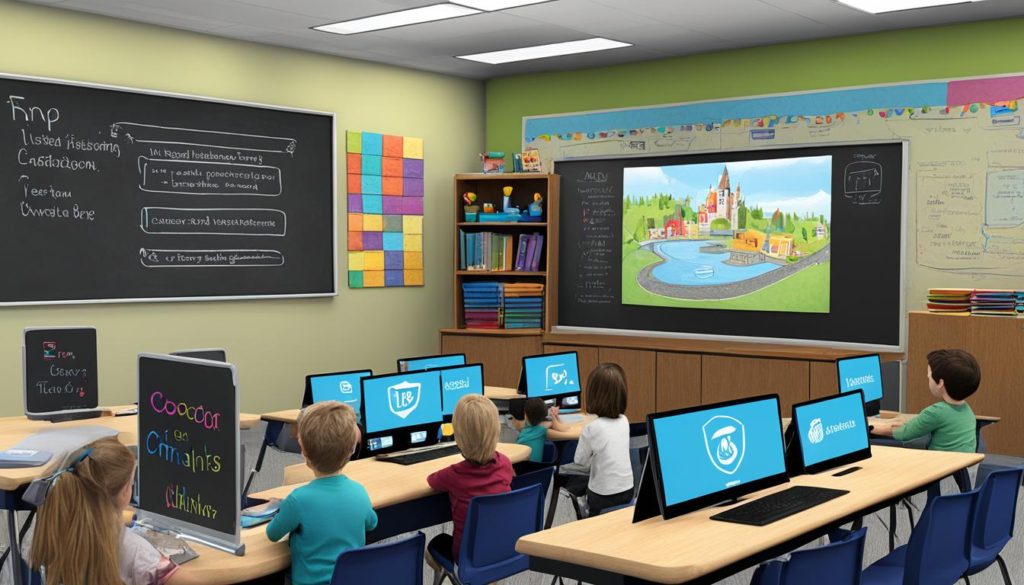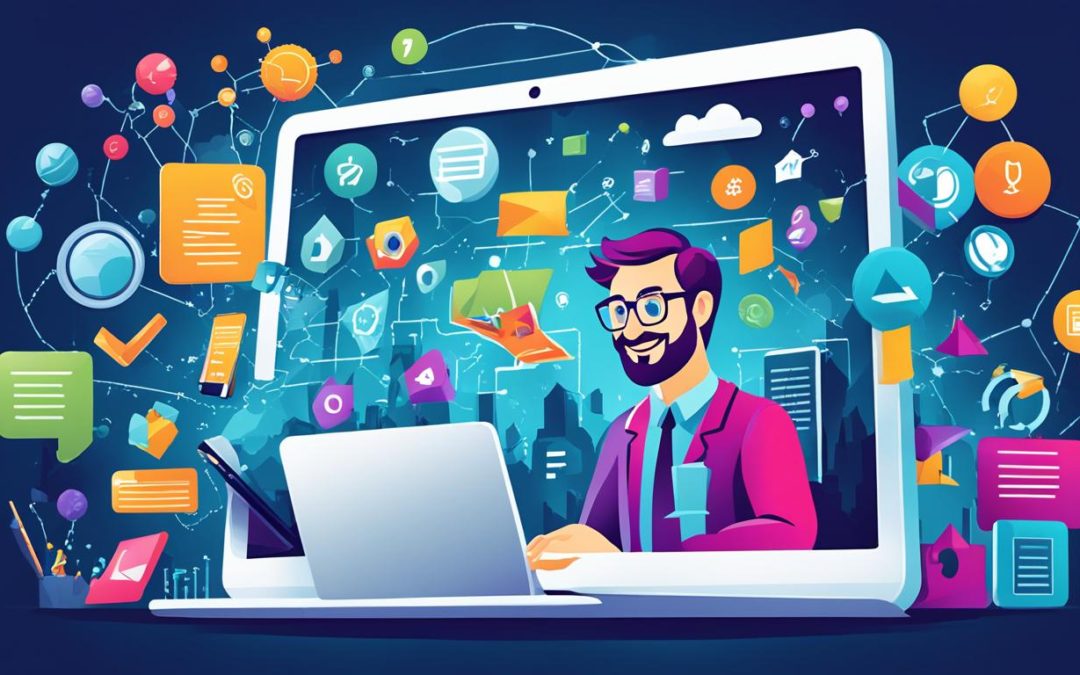Do you know the difference between e-learning and blended learning? They are both part of the growing world of online education. Understanding each can help you figure out what fits your study style.
Key Takeaways:
- E-learning uses digital technologies to deliver complete learning programs online, while blended learning combines online and in-person elements.
- E-learning offers flexibility and convenience, making it ideal for short-term practical training.
- Blended learning provides an immersive and personalized learning experience, suitable for long-lasting and complex organizational programs.
- Blended learning promotes social learning, fosters a sense of community, and enhances the application of knowledge.
- The future of education is likely to see a continued integration of e-learning and blended learning to maximize educational outcomes.
What is E-learning?
E-learning, or online learning, uses digital tools to teach. It lets you learn from any place with the internet. This makes learning more flexible than traditional methods.
It comes in many types. Some involve live video chats, where students share ideas instantly. Others let you study whenever you want, with pre-recorded videos or articles.
There are lots of e-learning websites today. For example, LinkedIn Learning, Coursera, and Udemy for Business. They have classes for many topics, helping with personal and work skills.
What is Blended Learning?
Blended learning is a mix of online and offline learning. It combines the best of digital and personal class time. Students, in these programs, meet in person once a month, work online every week, and talk online with classmates.
It brings together the good parts of online and in-person learning. This includes being able to learn from anywhere, and also building real relationships. Students can study on their own to really understand the subjects.
This way of learning is great for jobs. People can use what they learn right at work. It helps them keep their knowledge fresh and improves problem-solving and teamwork.
Howspace is a great online platform for blended learning. It's easy to use and fits different learning needs very well.
Blended learning is liked by many, from companies to schools. It mixes both e-learning's ease and personal learning's benefits.
Benefits of Blended Learning:
- Promotes social learning
- Encourages applied learning at work
- Facilitates hands-on training and practice
- Supports personalized learning experiences
- Enhances critical thinking and problem-solving skills
Blended learning is a game-changer by combining e-learning's flexibility with the depth of face-to-face learning.

| Blended Learning | E-Learning |
|---|---|
| Combines digital and in-person learning | Delivered entirely online |
| Promotes social learning and collaboration | Lacks face-to-face interactions |
| Allows for hands-on training and practice | Primarily focuses on information delivery |
| Offers flexibility and convenience | Provides flexibility, but lacks in-person support |
Hybrid Learning vs. Blended Learning
Often, people mix up blended and hybrid learning. But they're not quite the same. Blended learning is when everyone is together for classes. They meet face-to-face. This helps build a strong community and makes learning better.
Now, hybrid learning is different. It mixes both online and offline learning. In a hybrid setup, some join classes in person. Others join online. This setup is great for those who can't be there in person.
Hybrid learning is part of a bigger picture, called blended learning. It combines the best of offline and online learning. Choosing among offline, online, or a mix depends on what the program needs and the students' circumstances. The right choice can make learning more effective.
"Blended learning brings together the best of both worlds - the personal touch of face-to-face interactions and the flexibility of remote learning."
When choosing between the two, think about what the program needs. Some need lots of in-person time. Others can work well with a bit less in-person. Picking the right mix can make learning more successful for all.
Hybrid Learning vs. Blended Learning: A Comparison
| Aspect | Hybrid Learning | Blended Learning |
|---|---|---|
| Learning Location | Combination of physical location and remote participation | Physical location for face-to-face activities |
| Synchronous Interactions | Participants join remotely for synchronous interactions | Direct face-to-face interactions among participants |
| Flexibility | Allows for remote participation and accommodates scheduling conflicts | Offers less flexibility due to the requirement for physical presence |
Both hybrid and blended learning have their perks and things to consider. The best choice depends on the goals, resources, and needs of the program. Using the right mix can make learning more engaging and effective for everyone.
The Differences Between E-learning and Blended Learning
It's key to know how e-learning and blended learning differ. They differ in where you learn and how involved you are.
E-learning:
E-learning, or online learning, happens only on the internet. You can study from anywhere with a Wi-Fi connection. It lets you go at your own speed and pick where you learn. But, e-learning can feel like it's missing something. It's not very interactive or engaging, which can make learning harder.
Blended Learning:
Blended learning mixes e-learning and some face-to-face time. This way, you get the best of both worlds. You learn online and also get to work with others in real life. It makes your learning experience more alive and hands-on. With blended learning, you can understand things deeply and use what you learn in real life.
Part of your studies happens online, and part face-to-face. This mix makes learning much richer. You get a personal and deep learning experience.
| E-learning | Blended Learning |
|---|---|
| Takes place online | Combines online and in-person learning |
| One-directional learning | Interactive and immersive learning |
| Lacks contextual application | Encourages application of knowledge to real-world scenarios |
E-learning and blended learning each have their own strong points. E-learning is awesome for flexibility and easy access. Blended learning is even better. It's more lively, involves you more, and is very practical.

When to Choose E-learning?
E-learning is great for quick learning and practical skills. It's perfect if you want to learn fast and on your own time. Here's what to think about when deciding if e-learning works for you:
- Short-term courses: It's great for people who want to learn a lot in a short time. It could be about a new software or a specific topic. E-learning focuses on what you need to know.
- Practical training: If you like learning by doing, this is for you. E-learning uses videos and interactive activities. It turns theory into hands-on practice.
- Interactive exercises: E-learning uses quizzes and exercises to help you learn better. They let you check what you've learned right away.
- Flexibility and convenience: You get to choose when and where to learn. This is great for busy people or anyone who likes to learn at their own speed.
- Access to expert instructors and resources: You can learn from the best in the industry. Online forums help you ask questions and learn from others.
"E-learning is a powerful tool for acquiring new skills efficiently and conveniently, especially for short-term courses that emphasize practical training." - John Smith, Learning Expert
If you need to learn skills fast and want to do it interactively, e-learning is a good choice. It lets you learn at your own pace and connects you with many learning tools.
Comparison of E-learning and Blended Learning
| E-learning | Blended Learning |
|---|---|
| Short-term, focused courses | Longer-lasting, comprehensive programs |
| Interactive exercises and simulations | Combination of online and in-person activities |
| Flexible learning pace and schedule | Structured curriculum with periodic in-person sessions |
| Access to expert instructors and resources | Opportunities for group discussions and peer learning |
| Self-paced, independent learning | Promotes social interaction and collaborative learning |
E-learning and blended learning each have their benefits. They allow learners to find what suits them best. This could be based on your learning goals or how you like to learn.
When to Choose Blended Learning?
Blended learning is great for courses that last a long time and complex training, like leadership programs. It mixes online and in-person learning, meeting people's different needs.
This method lets students use what they've learned in their jobs. They practice real-world tasks, which makes things stick better. Plus, they stay in touch with the learning group for advice and to share ideas.
It also helps create a sense of belonging. So, people feel they're in it together. They discuss and learn from each other.
Think about a leadership boot camp. To lead well, you need more than just theories. This method blends online lessons with workshops and talks. It gives a full view of leading and how to do it in different places.
"Blended learning is perfect for leadership training. It lets people learn, practice, and help each other. This makes learning much better."
| Benefits of Blended Learning | Examples |
|---|---|
| Promotes a sense of community and belonging | Leadership training programs |
| Allows repeated application of knowledge | Complex organizational learning |
| Enables collaboration and peer learning | Team-building workshops |
Blended learning helps not just in leadership but in many areas. Any program that wants hands-on learning will find it useful. It's good for any course or training that's a big deal.
The Impact of Blended Learning in Complex Organizational Learning
For hard-to-learn stuff at work, blending online and classroom learning is perfect. It gives a full training experience, mixing lessons, practice at work, and help all the way. This makes it easier to handle work challenges.
This learning method is also great for grown-ups. It gives them time to learn on their own. They can study when it fits their schedule. This makes learning personal and easy for everyone.
So, for complex and long training, blended learning is smart. It keeps learning going, helps people work together, and gives a big win to learners and their bosses.
The Advantages of Blended Learning
Blended learning is better than just in-person or digital learning. It mixes both types to make learning fun and interesting. Here are some of its top perks:
- Flexibility and Personalization: Blended learning lets you learn online and meet people in class. Students can study online and join group talks when they want. Each person can set up their learning to match what they like and need.
- Sense of Community: It makes students feel like they belong. Although learning online can feel lonely, mixing it with classroom time helps create friendships. This makes students want to learn more and work together.
- Student-Student Interaction: Blended learning helps students work together. They get to talk in groups, work on projects, and join in on activities. This helps with thinking critically and getting better at teamwork.
- Student-Instructor Interaction: Students can talk one-on-one with their teachers in blended learning. In class, they can ask questions and get help right away. Teachers can explain tough stuff better and give students the support they need.
Blended learning brings online tools into classrooms. It makes learning full and engaging. This type of learning helps students gain more knowledge and skills. It uses tech to connect people and makes learning fun and effective.
The Future of E-learning and Blended Learning
The way we learn is changing fast, thanks to online and blended learning. Both these methods mix tech and in-person learning to make studying better. They fit right into our high-tech world.
Blended learning uses both the internet and traditional classes. So, it's good for learning in different places. It gives students a full learning experience by blending virtual and real-world learning.
Blended learning is also great for learning from far away. It connects the old way of learning in classrooms with new, online methods. Students can join online discussions and still see their classmates in person. This mix could become the main way we learn in the future, combining the best of both worlds.
Let's compare traditional schooling with blended learning to see the advantages.
| Traditional Education Model | Blended Learning Model | |
|---|---|---|
| Learning Environment | In-person classroom | Combination of online and in-person |
| Flexibility | Less flexibility in terms of time and location | Greater flexibility to learn anytime, anywhere |
| Social Interaction | Primarily limited to in-person interactions | Includes both online and in-person interactions with peers and instructors |
| Student Engagement | Relies on traditional teaching methods | Combines digital resources, interactive activities, and face-to-face instruction |
| Personalized Learning | Limited opportunities for individualized instruction | Allows for personalized instruction tailored to individual needs |
This table shows how blended learning brings the best of both worlds together. It offers students a unique, personalized way to learn.
Using e-learning and blended learning is a smart move for the future of education. It makes learning more fun and accessible. Also, it helps students work together and stay engaged. These new ways to learn lead us into an exciting future, full of learning and growing.
Conclusion
In today's world, e-learning and blended learning are key. E-learning is great for quick, specific training. Blended learning, on the other hand, makes learning more personal for deep and long projects. Knowing the benefits of both helps people choose wisely.
In e-learning, you can learn when and where you want. This lets you go at your own speed. There are materials and interactive tasks for practical learning. Blended learning mixes online lessons with in-person time. It helps apply knowledge in real life and get feedback from others.
Both e-learning and blended learning will keep getting more popular. Technology is always improving, making online learning better. The mix of e-learning's flexibility and blended's hands-on feel suits many. This way, education can meet students' needs more directly, helping them reach their goals.
FAQ
What is e-learning?
E-learning uses digital tools to offer learning programs. It might be through activities or just reading. This method allows people to learn from anywhere with an internet connection.
What is blended learning?
Blended learning mixes online learning with in-person classes and self-study. It lets you learn more deeply, while still being flexible. This way, you get the best of both worlds.
What is the difference between blended learning and hybrid learning?
Blended learning has everyone meeting for face-to-face sessions. Hybrid learning, on the other hand, has some physically together and some joining in remotely. So, it adds an online element to traditional classes.
What are the main differences between e-learning and blended learning?
E-learning is fully online. In contrast, blended learning mixes online and in-person classes. Blended learning makes learning more real by tying it with actual life situations.
When should I choose e-learning?
Choose e-learning for quick, hands-on lessons. It's good for when you need to watch videos, do interactive tasks, and ask questions. Plus, you can go at your own speed and pick when to study.
When should I choose blended learning?
Go for blended learning for longer, complex courses like leadership training. It helps you keep using what you learn in real life and offers support. You also feel more connected with classmates and teachers, making learning richer.
What are the advantages of blended learning?
Blended learning boosts community and makes learners feel connected. It mixes the freedom of online learning with the value of meeting others face-to-face. This combo provides a tailored, meaningful learning journey.
What is the future of e-learning and blended learning?
Both e-learning and blended learning are growing in the education future. Blended learning, especially, is seen as a flexible choice for learning from a distance. It might become the main way we learn in the coming years.









